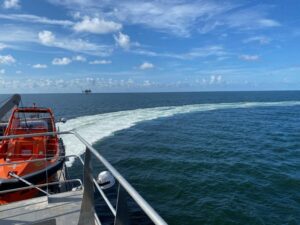The Navy tested a set of events last month to assess autonomous capabilities integrated into the future Spearhead-class USNS Apalachicola
(EPF-13), the service said July 29.
The Navy said the test events, called the Unmanned Logistics Prototype trials, each increase the perception capability and behavior complexity performed by the autonomous systems. Thus far, test evolutions included point-to-point autonomous navigation, vessel handling and transfer of vessel control between manned to unmanned modes.
This prototyping work aims to demonstrate a large ship, in this case EPF-13, can be fielded with some autonomous capabilities to be a “self-driving platform,” the service said.

In 2021, the Navy awarded the EPF shipbuilder, Austal USA, a $44 million contract modification to build and demonstrate this autonomous capability. At the time, Austal said the contracted enhancements include installing a perception and autonomy control suite and automation enhancements to the machinery plant that improve hull, mechanical and electric reliability while also reducing the amount of personnel needed for operations at sea (Defense Daily, June 9, 2021).
The company noted it had already designed the base EPF with a highly automated machinery plant to save cost and centralize operations on the bridge, requiring a smaller ship crew, before adding these automation features.
Tim Roberts, Strategic and Theater Sealift program manager at Program Executive Office Ships, underscored the kinds of autonomous capabilities being demonstrated in this prototype form “represent a major technological advancement for the EPF platform, the Navy at large and our industry partners. EPF-13 will be the first fully operational U.S. naval ship to possess autonomous capability including the ability to operate autonomously in a commercial vessel traffic lane.”
“This testing is a game changer and highlights that there is potential to expand unmanned concepts into existing fleet assets,” he added.
The Navy said in the future test events will add more difficulty levels, night navigation and differing weather and sea states.
The service argued these trials are setting the groundwork for other autonomous operations in the future like vessel encounter and avoidance maneuvering and compliance with International Regulations for Preventing Collisions at Sea, known as COLREGS.
EPF-13 is set to deliver to the Navy later this year. According to the Navy’s FY ‘23 budget request documents, it is planned to be delivered this September and be ready for use by 2023.
The Spearhead-class are shallow draft vessels designed for quick intra-theater transportation of personnel and equipment. They can load and unload in austere ports without relying on shore-based infrastructure.
EPF-14, -15 and -16, next in production, are planned to have modifications to give them the Role 2 Enhanced Medical Transport mission, which includes enhanced medical capabilities as the Navy explores how to supplement and ultimately replace the two Mercy-class hospital ships, USNS Mercy (T-AH 19) and Comfort (T-AH 20).